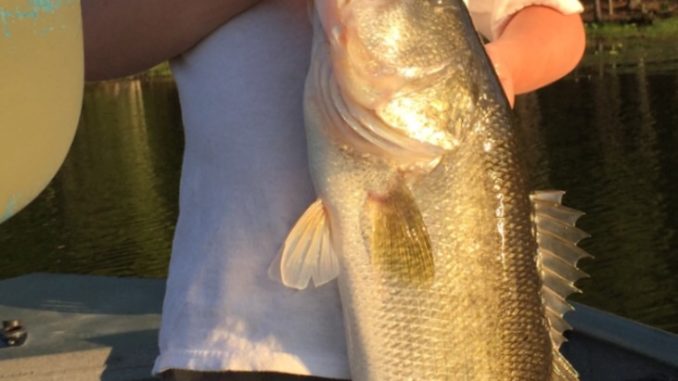
11 fishing sites are scattered throughout the 800-acre lake
The N.C. Wildlife Resources Commission, along with N.C. B.A.S.S. and the City of High Point, recently opened an educational fishing trail on Oak Hollow Reservoir to teach anglers how to catch largemouth bass and other sport fish during different times of the year.
The Oak Hollow Fishing Trail, which is accessible only by boat, consists of 11 fishing sites scattered around the 800-acre reservoir. The sites are enhanced with fish attractors to attract largemouth bass and other sport fishes. Six of the sites are located in habitats where fish can be found in summer and winter, such as old roadbeds and humps with access to deeper waters of the reservoir. Five sites are located in shallow-water habitats where fish are found in the spring, during pre- and post-spawning times.
“Largemouth bass and other sport fish use different habitats throughout the year,” said Mark Fowlkes, the Commission’s Piedmont Aquatic Habitat Coordinator. “These seasonal movements and habitat patterns are instinctive and triggered by changes in water temperature, daylight hours, spawning and feeding.”
In the spring, prior to the spawning season, largemouth bass congregate in areas such as in river and creek channels near shallow flats. When fish begin to spawn they will move into shallow coves, onto flats and around points, in about 1 to 5 feet of water. They will spawn then slowly move into the open or deeper waters to spend the heat of the summer. As water temperatures decline in the fall, largemouth bass often move to the same creeks where they were found in the spring, searching for food. In the winter, they move to deeper water because of the short days and cold water temperatures.
“Teaching anglers about seasonal movements of fish can help increase their angling success and make fishing more enjoyable,” said Bill Frazier, conservation director for N.C. B.A.S.S. “These principles can be used on other reservoirs, but it is important to remember that each reservoir is unique.”
Youth members of N.C. B.A.S.S. helped design, build and install the structures for each site using leftover materials from a previous Boy Scout fish attractor project. The Commission helped pay for some construction materials and buoy markers, and designed the brochure with money from the Sport Fish Restoration Program.
“We appreciate the Commission’s leadership in partnering with National and N.C. B.A.S.S Conservation and Youth programs,” Frazier said. “Giving kids the opportunity to design and build the site structures was a great way to get them involved in learning about fish habitat while creating great fishing opportunities for the public — an experience we hope can be duplicated in other reservoirs depending upon the success of the Oak Hollow Fishing Trail.”
Because the Oak Hollow Fishing Trail is a pilot project, Commission staff will be evaluating its success through a survey that anglers can fill out after fishing the trail. Anglers interested in fishing the trail are encouraged to pick up a brochure at the Oak Hollow Marina office. In addition to the survey, the brochure contains a map and a list of the sites, including GPS coordinates, as well as general habitat information.
“It’s imperative for fishermen to fill out the survey, list what they caught at each station and return the survey to marina staff,” Fowlkes said. “This will let us know if the structures and locations are working. If this fishing trail is deemed a success, it could be replicated in other reservoirs throughout the state, working with N.C. B.A.S.S. and other local governments.”
The Oak Hollow Fishing Trail currently is the first of its kind in North Carolina to educate the public on the seasonal movements of largemouth bass and other sport fishes.
The Oak Hollow Marina charges $7 to launch a motor boat. Anglers 16 and older will need a fishing license to fish at Oak Hollow, which they can purchase at the marina and also by clicking here.
For more information about freshwater fishing in North Carolina, including an interactive map of public fishing sites across the state, clck here. visit www.ncwildlife.org/fishing.



Be the first to comment